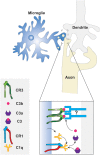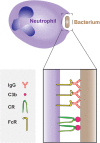Diversity and Versatility of Phagocytosis: Roles in Innate Immunity, Tissue Remodeling, and Homeostasis
- PMID: 28589095
- PMCID: PMC5440456
- DOI: 10.3389/fcimb.2017.00191
Diversity and Versatility of Phagocytosis: Roles in Innate Immunity, Tissue Remodeling, and Homeostasis
Abstract
Phagocytosis, a critical early event in the microbicidal response of neutrophils, is now appreciated to serve multiple functions in a variety of cell types. Professional phagocytes play a central role in innate immunity by eliminating pathogenic bacteria, fungi and malignant cells, and contribute to adaptive immunity by presenting antigens to lymphocytes. In addition, phagocytes play a part in tissue remodeling and maintain overall homeostasis by disposing of apoptotic cells, a task shared by non-professional phagocytes, often of epithelial origin. This functional versatility is supported by a vast array of receptors capable of recognizing a striking variety of foreign and endogenous ligands. Here we present an abbreviated overview of the different types of phagocytes, their varied modes of signaling and particle engulfment, and the multiple physiological roles of phagocytosis.
Keywords: macrophage; neutrophil; phagocyte; phagocytosis; phagosome.
Figures





References
-
- Aida Y., Pabst M. J. (1990). Priming of neutrophils by lipopolysaccharide for enhanced release of superoxide. Requirement for plasma but not for tumor necrosis factor-alpha. J. Immunol. 145, 3017–3025. - PubMed
Publication types
MeSH terms
Grants and funding
LinkOut - more resources
Full Text Sources
Other Literature Sources

